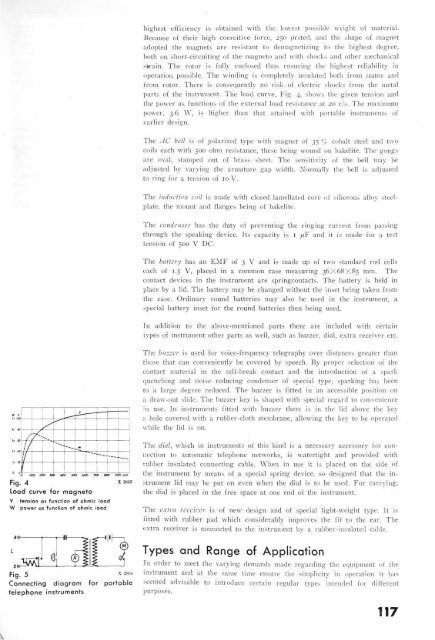contents - History of Ericsson - History of Ericsson
contents - History of Ericsson - History of Ericsson
contents - History of Ericsson - History of Ericsson
You also want an ePaper? Increase the reach of your titles
YUMPU automatically turns print PDFs into web optimized ePapers that Google loves.
highest efficiency is obtained with the lowest possible weight <strong>of</strong> material.<br />
Because <strong>of</strong> their high coercitive force, 250 pYsted, and the shape <strong>of</strong> magnet<br />
adopted the magnets are resistant to demagnetizing to the highest degree,<br />
both on short-circuiting <strong>of</strong> the magneto and with shocks and other mechanical<br />
storain. The rotor is fully enclosed thus ensuring the highest reliability in<br />
operation possible. The winding is completely insulated both from stator and<br />
from rotor. There is consequently no risk <strong>of</strong> electric shocks from the metal<br />
parts <strong>of</strong> the instrument. The load curve, Fig. 4, shows the given tension and<br />
the power as functions <strong>of</strong> the external load resistance at 20 c/s. The maximum<br />
power, 3.6 W, is higher than that attained with portable instruments <strong>of</strong><br />
earlier design.<br />
The AC bell is <strong>of</strong> polarized type with magnet <strong>of</strong> 35 % cobalt steel and two<br />
coils each with 500 ohm resistance, these being wound on bakelite. The gongs<br />
are oval, stamped out <strong>of</strong> brass sheet. The sensitivity <strong>of</strong> the bell may be<br />
adjusted by varying the armature gap width. Normally the bell is adjusted<br />
to ring for a tension <strong>of</strong> 10 V.<br />
The induction coil is made with closed lamellated core <strong>of</strong> siliceous alloy steelplate,<br />
the mount and flanges being <strong>of</strong> bakelite.<br />
The condenser has the duty <strong>of</strong> preventing the ringing current from passing<br />
through the speaking device. Its capacity is 1 ^F and it is made for a test<br />
tension <strong>of</strong> 500 V DC.<br />
The battery has an EMF <strong>of</strong> 3 V and is made up <strong>of</strong> two standard rod cells<br />
each <strong>of</strong> 1.5 V, placed in a common case measuring 36X68X85 mm. The<br />
contact devices in the instrument are springcontacts. The battery is held in<br />
place by a lid. The battery may be changed without the inset being taken from<br />
the case. Ordinary round batteries may also be used in the instrument, a<br />
special battery inset for the round batteries then being used.<br />
In addition to the above-mentioned parts there are included with certain<br />
types <strong>of</strong> instrument other parts as well, such as buzzer, dial, extra receiver etc.<br />
The buzzer is used for voice-frequency telegraphy over distances greater than<br />
those that can conveniently be covered by speech. By proper selection <strong>of</strong> the<br />
contact material in the self-break contact and the introduction <strong>of</strong> a spark<br />
quenching and noise reducing condenser <strong>of</strong> special type, sparking has been<br />
to a large degree reduced. The buzzer is fitted in an accessible position on<br />
a draw-out slide. The buzzer key is shaped with special regard to convenience<br />
in use. In instruments fitted with buzzer there is in the lid above the key<br />
a hole covered with a rubber-cloth membrane, allowing the key to be operated<br />
while the lid is on.<br />
The dial, which in instruments <strong>of</strong> this kind is a necessary accessory for connection<br />
to automatic telephone networks, is watertight and provided with<br />
rubber insulated connecting cable. When in use it is placed on the side <strong>of</strong><br />
the instrument by means <strong>of</strong> a special spring device, so designed that the instrument<br />
lid may be put on even when the dial is to be used. For carrying,<br />
the dial is placed in the free space at one end <strong>of</strong> the instrument.<br />
The extra receiver is <strong>of</strong> new design and <strong>of</strong> special light-weight type. It is<br />
fitted with rubber pad which considerably improves the fit to the ear. The<br />
extra receiver is connected to the instrument by a rubber-insulated cable.<br />
Types and Range <strong>of</strong> Application<br />
In order to meet the varying demands made regarding the equipment <strong>of</strong> the<br />
instrument and at the same time ensure the simplicity in operation it has<br />
seemed advisable to introduce certain regular types intended for different<br />
purposes.<br />
117
















